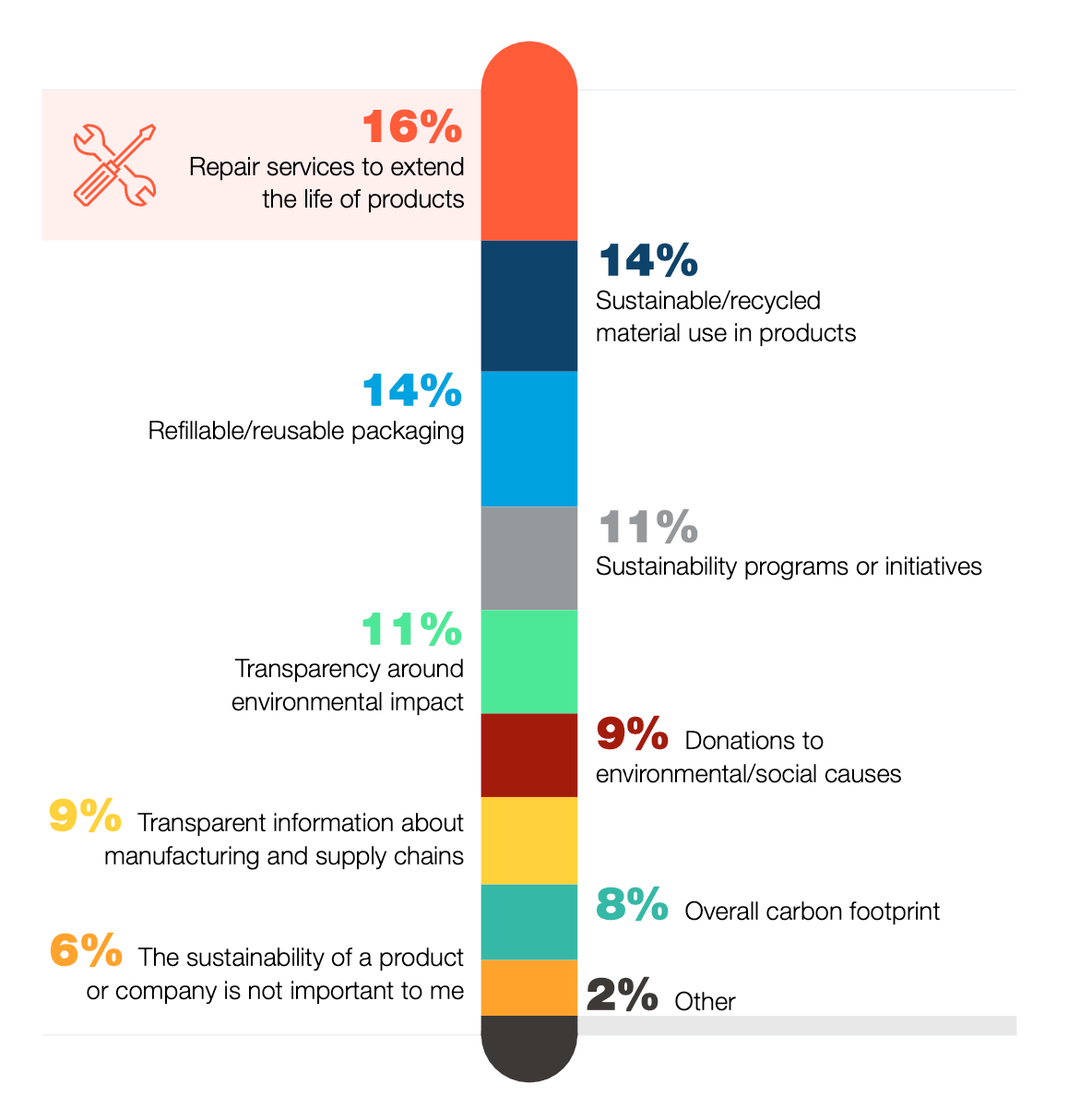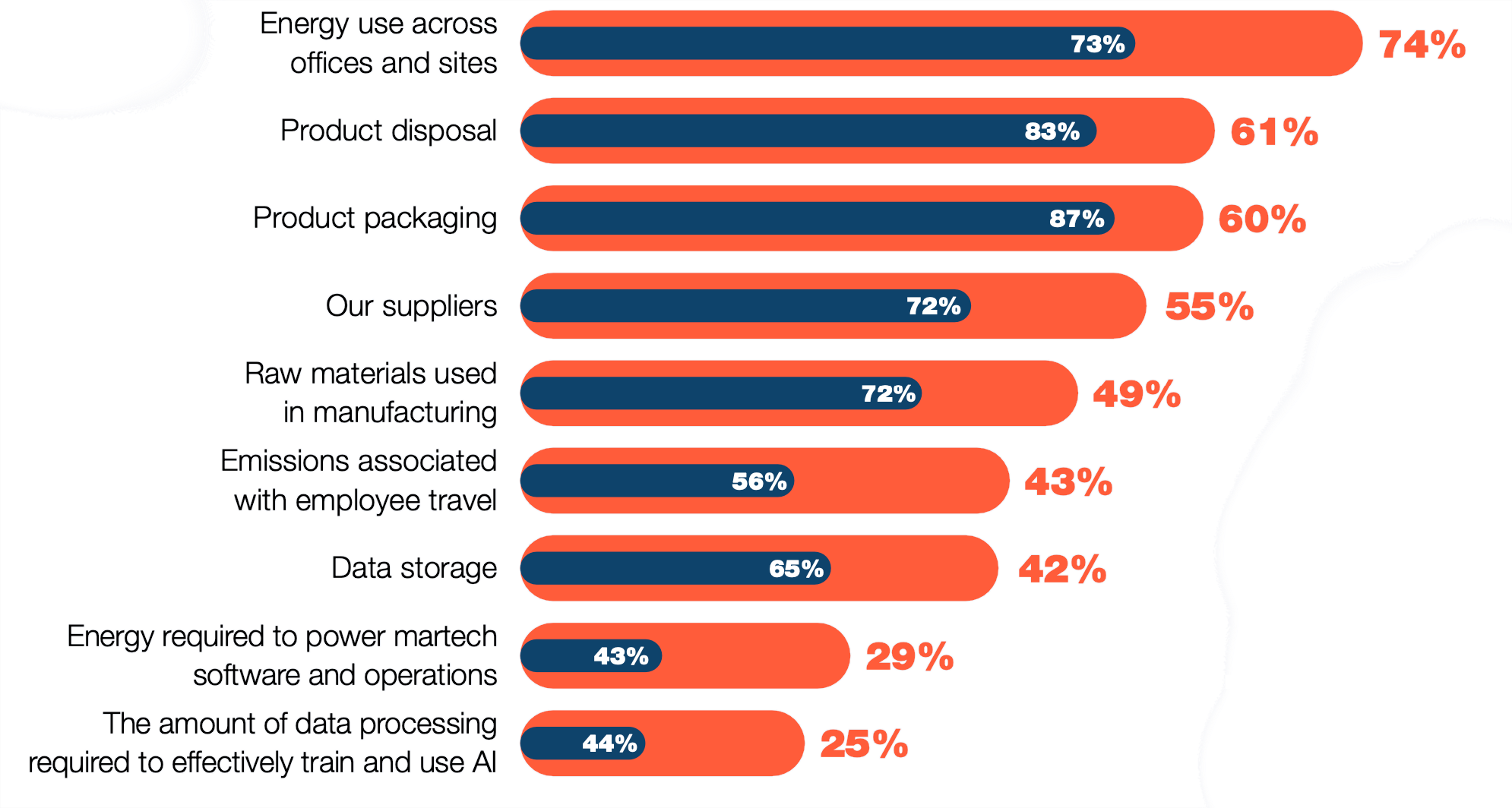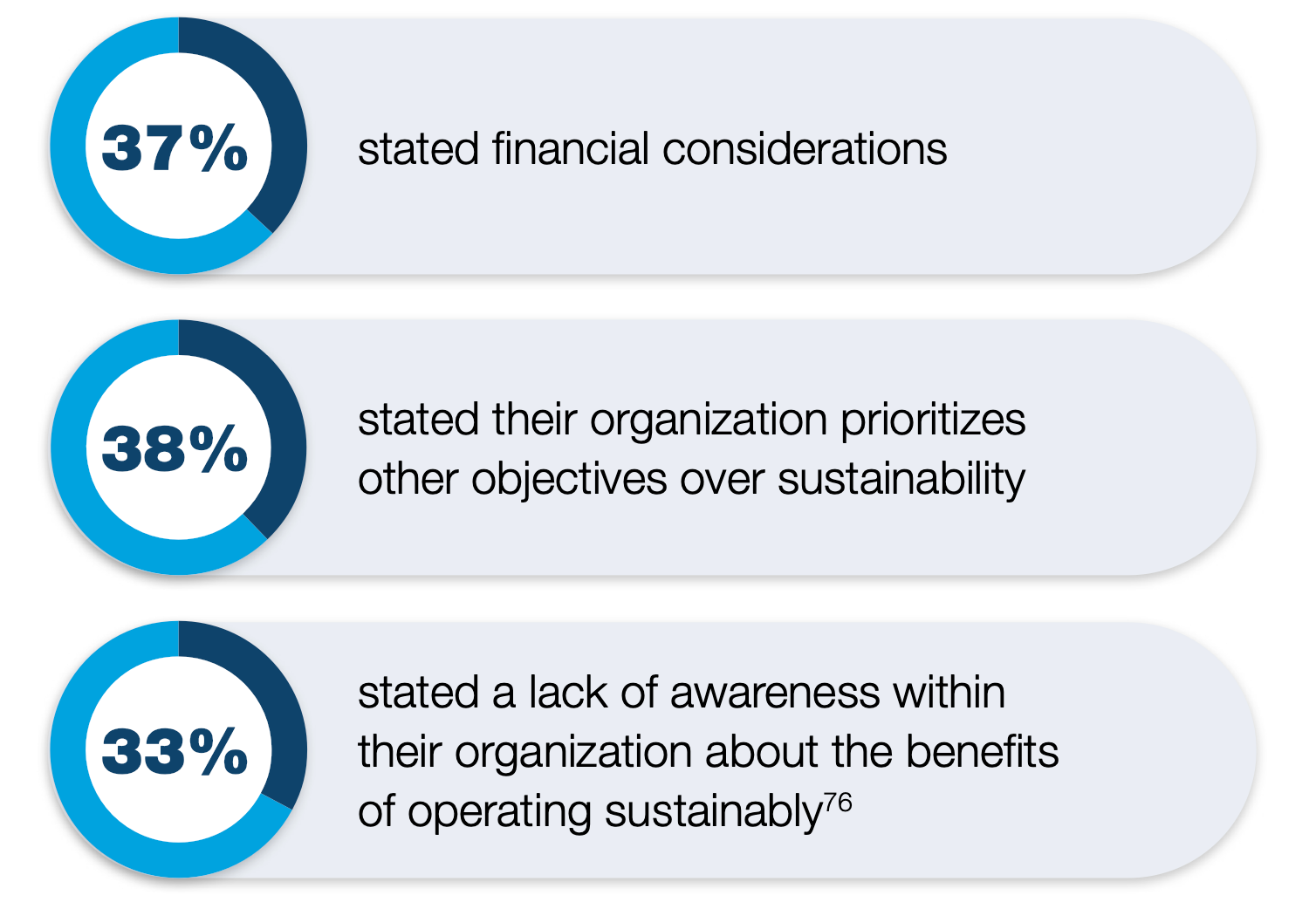Are You Ready for Marketing Made Better?
We can help you understand your customers, stay ahead of regulations, and grow your business.
Sustainability is influencing people’s purchase decisions and their perceptions of brands.
In recent years, when making purchase decisions, people have become more mindful of sustainability – encompassing social, environmental, and economic aspects. They want to feel good about the products they buy, and by extension, the brands they’re investing in, so sustainability is becoming synonymous with good CX.

With economic uncertainty putting pressure on people’s wallets, there’s the potential for considerations such as affordability to push sustainability down the priority list. But our research indicates sustainability is still a key concern, and consumers tend to favor brands that promote social messages that align with their own beliefs, employ sustainable manufacturing practices, and uphold ethical business standards.
Over two-fifths (41%) of the consumers we surveyed say the environmental impact of a company is a key factor that influences their purchasing decisions. And 38% say the same for a company’s social impact67. Environmental impact is most important for younger consumers aged 16-34 but is still a significant factor for those between 35 and 54.
The demand for more sustainable products isn’t necessarily limited to high-income countries. Google’s global search data suggests that the desire to learn about and practice sustainability is trending worldwide. Whether it’s electric vehicles, fast fashion, zero waste, or renewable energy, internet users across the globe are searching for the information they need to make more sustainable choices68.
Sustainability credentials aren’t just influencing what consumers buy, they’re also impacting what they don’t buy. Around half (47%) of the consumers we surveyed say they would avoid purchasing from a company if they had concerns about their environmental impact, and over half (52%) say the same about the company’s stance on ethical or social issues (52%)69.
This means brands need to be cautious about just paying lip service to sustainability through greenwashing. Consumer expectations extend beyond mere claims; they want to see evidence of a genuine commitment to sustainability through the products, services, and operations of the businesses they interact with.
Businesses need to go beyond marketing messaging and embed sustainability across their organization, to ensure they’re practicing what they preach. This can be a complex and expensive process, but businesses that get it right will avoid alienating people and can expect to reap the long-term benefits of customer loyalty and brand affinity.
Case Study
Nike has implemented a 360-degree approach to sustainability throughout its operations, supply chains, products, and culture. With the launch of “Move to Zero” in 2019, Nike set out its sustainability vision with specific and measurable goals to achieve by 2025 and 2050. Nike focuses its social and environmental efforts in four key areas:
Environmentally sustainable operations: Nike is working toward a 70% reduction in greenhouse gas emissions by 2025, which includes diverting 100% of waste from landfills, and using 100% renewable energy across all its owned facilities.
Recycling and refurbishing: Nike uses recycled leather, cotton, polyester, and nylon in its shoes. The company has also developed materials with low manufacturing impact that are composed of recycled plastic. In addition, Nike offers take-back and refurbishment programs for used and end-of-life footwear.
Diversity, equity, and inclusion: Nike has pledged to achieve 50% representation of women and 35% representation of racial and ethnic minorities in its corporate workforce by 2025. The company has also committed to investing $125 million in businesses that address racial inequality, and $140 million over 10 years (to 2030) to support social equality for Black Americans.
Nike also equips customers with information to help them make more sustainable purchasing decisions. This includes their sustainability portal. Nike’s portal enables consumers to track Nike’s progress against its sustainability goals and to understand exactly how and where their shoes were made.
Manufacturing map: Nike’s “Manufacturing Map” enables consumers to learn where products are manufactured, the number of workers in each factory, their average age, and the number of migrant workers.
Consumer perspective:
People want businesses to adopt sustainable practices, and they are willing to pay a premium for products and services that are made in an environmentally friendly way. In fact,
44% of the people we surveyed say they are willing to pay more for a product or service if they think it’s more sustainable than an alternative. And business may be missing an opportunity here as 45% of consumers feel it’s hard to find products that are truly sustainable70.
Brands are responding by developing sustainability and social responsibility initiatives, making climate pledges, publishing sustainability reports, and establishing senior positions dedicated to sustainability.
But with expectations around sustainability evolving and people having more access to information about companies than ever before, brands need to make sure their sustainability pledges have substance and aren’t just empty promises.

We’ve already seen that almost half of consumers would avoid purchasing from a company where they have concerns about the organization’s environmental impact.
To understand what aspects of sustainability people are really interested in when deciding whether to spend their money with a particular company or not, we asked our survey respondents to select the factor that is most important to them.
Tellingly, only 6% said they didn’t find the sustainability of a product or company important.
Most important factors for consumers when considering the sustainability of a product or company, ranked from most to least important.71
Business perspective:
Overall, our survey demonstrates that sustainability is a key consideration for organizations. We found:

So, what steps are businesses actually taking to minimize their environmental impact? We asked the business professionals who took part in our survey to identify areas where their organization considers environmental impact, and to indicate whether or not the business has actually taken steps to minimize impact in these areas.


Some aspects such as energy use, product disposal, and product packaging are commonly considered by businesses. And the majority of organizations that consider these aspects do take action to minimize their environmental impact.
But it’s a different story when we look at data storage, the energy required to power martech software, and the data processing required for effective use of AI. The majority of businesses don’t consider these, and those that do aren’t necessarily taking action.
Over the last 15 years, data has become a hot commodity. Across sectors, organizations have raced to gather as much data as possible to inform strategic marketing initiatives, product development, and customer experience strategies. But as the volume of data workloads increases, so too does the environmental impact of data processing.
The growing popularity of martech software and AI-powered applications may well increase the carbon intensity of businesses that use these tools, as query processing takes a considerable amount of energy. AI models need to be continually fed data and updated on a regular basis, which further contributes to a businesses’ carbon footprint.

While the use of AI may initially contribute to carbon emissions, it can help companies become more sustainable in the long term.
Automate customer service: As its accuracy increases, conversational AI has the potential to become the most energy-efficient customer service solution by reducing the number of customer service touchpoints and staffing requirements, and streamlining operations.
Minimize waste: From FMCG brands to fashion retailers, businesses can use AI for demand forecasting and inventory management to reduce waste.
Improve product longevity: AI can be used both to design products that have a longer lifespan and for predictive maintenance, which will ensure products can function more efficiently for a longer period of time.
Facilitate more focused marketing communications: By using AI to optimize marketing communications, businesses can ensure that their campaigns reach the people most likely to engage. This can reduce emissions by limiting unnecessary data processing and avoiding energy-intensive, untargeted mass-marketing campaigns that don’t generate a strong ROI.
Provide more sustainable end‐to‐end CX: Companies can use AI to provide customers with information that helps them make sustainable choices. For example:
Pushing forward with sustainability isn’t always easy, especially in an increasingly difficult economic context. We discovered a number of businesses face key challenges when implementing sustainability initiatives:

In the current climate, businesses may need to gradually revise how they operate, and consider the changes they can make with the systems and applications they currently have, rather than contemplating a complete overhaul. For instance, legacy data systems and centers that have been in place for years may not be as energy efficient as cloud options, but they may be too costly to replace right away, meaning businesses need to start with incremental improvements.
From a data perspective this could include:
“At the moment, you’ve got this misalignment. Every company wants more data on their customers so they can personalize the experience. Not all data is relevant, but everything out there points toward analyzing more data, which is obviously very energy intensive. … But if you want to reduce your environmental impact, you need to have less data. The important thing to understand is, that doesn’t have to be a bad thing, especially if you are focusing on high-quality data instead.
Strategy Lead, AI Infrastructure Platform
In 2024 and beyond, businesses will need to take a holistic approach to sustainability to truly engage customers who are taking environmental and social issues seriously and avoid greenwashing accusations.
They will need to ensure they are aligned with their customers’ sustainability priorities. Our survey shows only 28% of businesses feel providing information to customers on the environmental impact of products is a key priority77, which is a huge missed opportunity as many people are struggling to find sustainable products and are willing to pay more for them when they do.
Businesses will need to evaluate the sustainability of their activities across all business units, including optimizing their data strategy to reduce its environmental impact. In fact, as businesses increasingly use AI to help them
operate more sustainably across multiple business operations, including energy usage, supply chain management, waste management, product development, and customer experience, ensuring sustainable management of the data that feeds AI will be a business imperative.
Successful companies will be those that put AI-driven sustainability at the core of their strategy. Rather than thinking of it as a checkbox, they will consider how sustainable operations can increase efficiency and profitability, enhance the experience for their customers, and differentiate their business.
We can help you understand your customers, stay ahead of regulations, and grow your business.